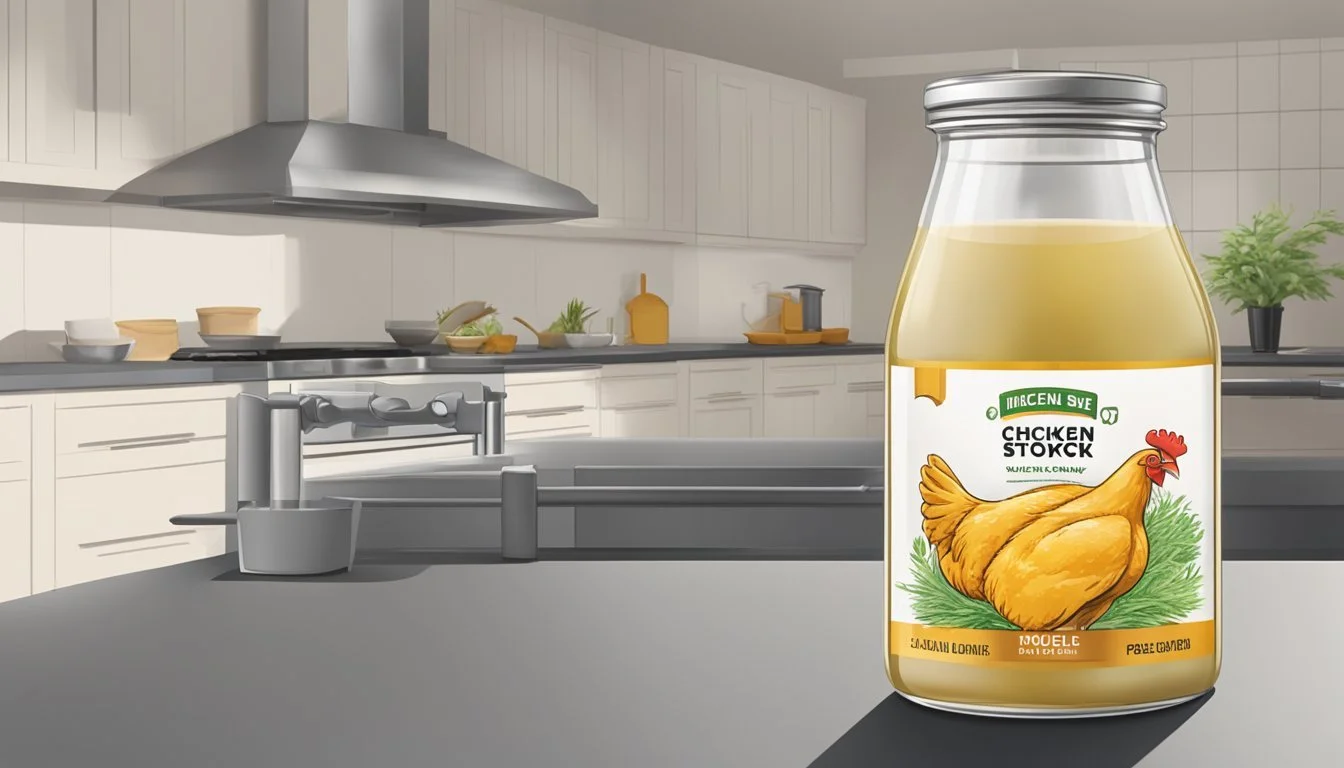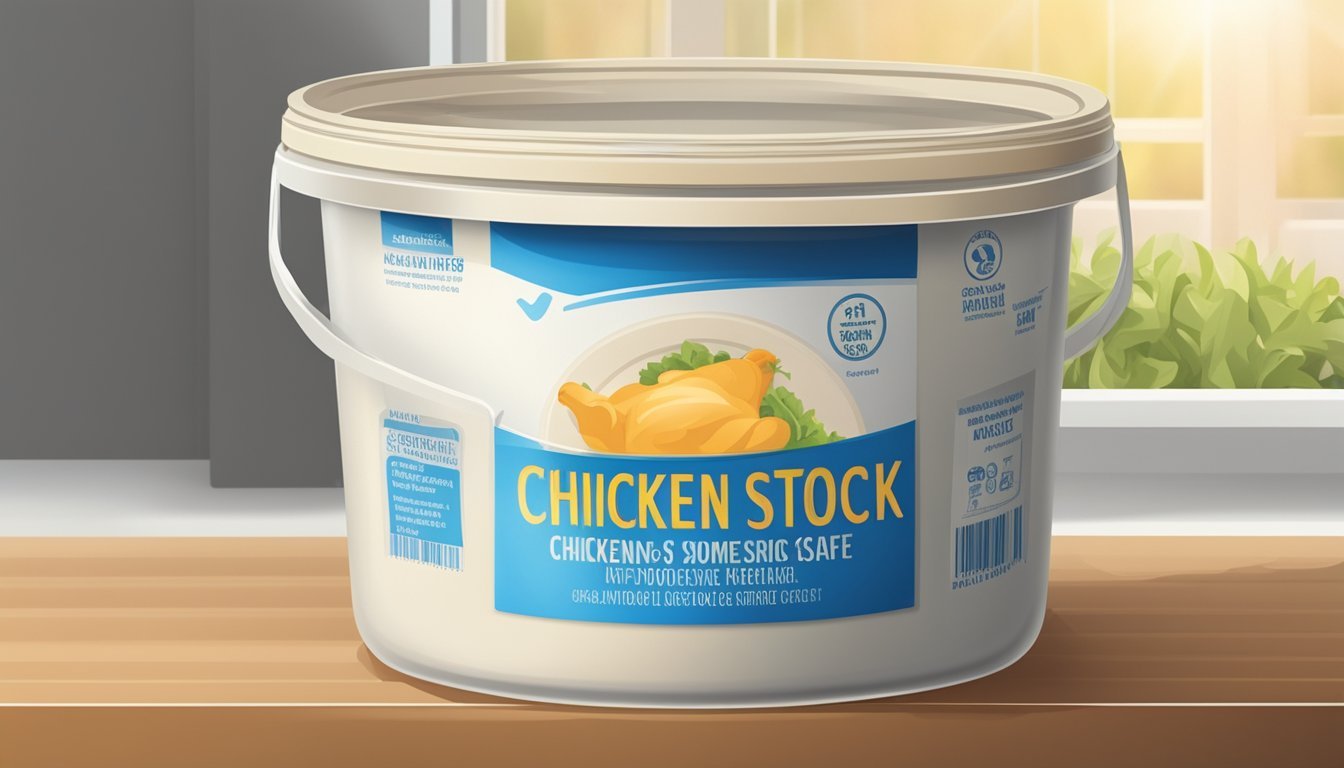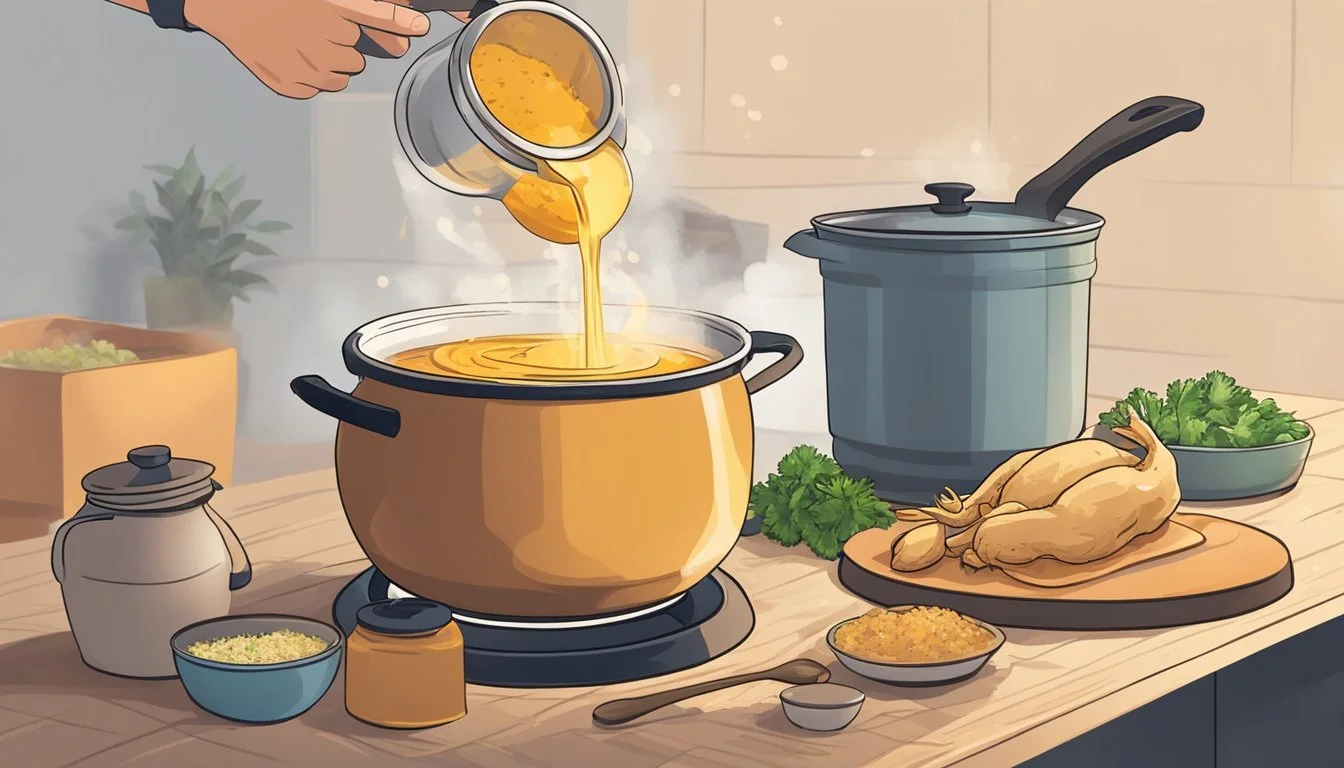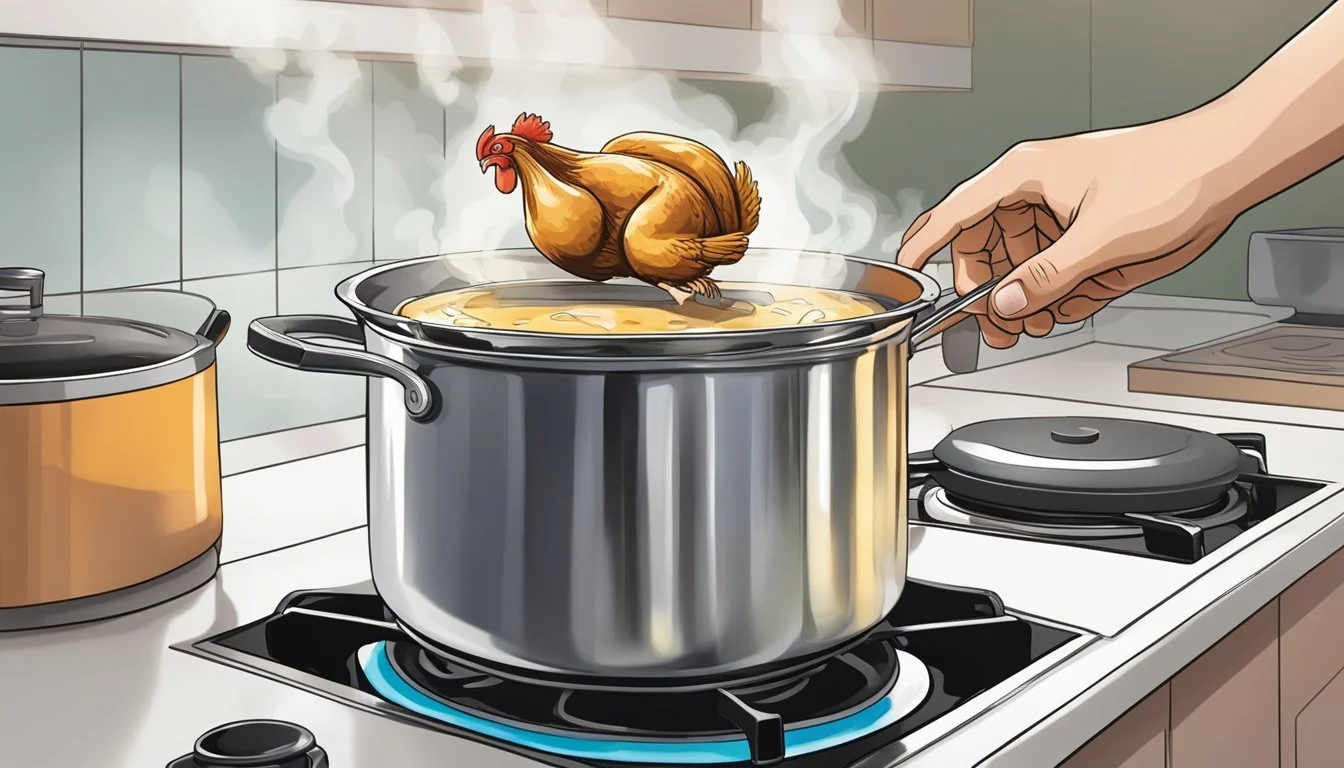Does Chicken Stock Spoil? Essential Storage Tips
Chicken stock is a staple in many kitchens, but like all perishable goods, it does have a shelf life. Yes, chicken stock can spoil, and knowing when it has gone bad is crucial for both safety and quality. Typical signs of spoilage include an off smell, unusual color, or mold growth.
Storage plays a significant role in prolonging the life of chicken stock. Unopened canned or boxed chicken stock can last up to a year when stored in a cool, dry place. Homemade chicken stock, on the other hand, typically only lasts 3-4 days in the fridge but can be frozen to extend its shelf life considerably.
Once opened, any chicken stock should be used within 5-14 days, depending on the storage recommendations provided. Properly understanding these storage guidelines ensures that the stock maintains its high quality and remains safe for consumption.
Understanding Chicken Stock
Chicken stock, mainly used as a base for soups and sauces, varies in its preparation and storage methods. Both homemade and store-bought options have distinct characteristics and requirements for maintaining freshness and safety.
Homemade vs. Store-Bought
Homemade chicken stock is typically made by simmering chicken bones, vegetables, and herbs in water for several hours. This method allows for customization, letting one control ingredients and seasoning levels. Homemade chicken stock usually has a richer, more robust flavor compared to its store-bought counterpart.
Store-bought chicken stock offers convenience with consistent taste and longer shelf life due to preservatives. It comes in cartons, cans, or broth concentrates. Store-bought chicken stocks often carry a "best before" date, ensuring consumers are aware of the ideal timeframe for using the product.
Storage Basics
Proper storage is crucial for both homemade and store-bought chicken stocks. Homemade chicken stock should be cooled quickly and stored in airtight containers in the refrigerator, where it remains safe for 3-4 days. If freezing, it can retain its quality for up to 2-3 months. Labeling with the date of preparation helps in keeping track.
Store-bought chicken stock, if unopened, can be stored in a cool, dry pantry for months until its best-before date. Once opened, it should be transferred to an airtight container and stored in the refrigerator, where it can stay fresh for up to 5 days. Freezing is also an option to extend its shelf life.
Signs of Spoilage
Recognizing spoilage in chicken stock is crucial to ensure its safety and quality. Key indicators include visual, textural, and olfactory changes that can signal the presence of harmful bacterial growth.
Visual and Textural Changes
Spoiled chicken stock often presents noticeable visual changes. The most common sign is a cloudy appearance which suggests bacterial activity. Mold growth on the surface is another clear indication that the stock has gone bad.
Unusual textures, such as sediment or a gelatinous consistency, can also signify spoilage.
If the chicken stock has become unusually thick or forms a layer of fat that doesn’t dissipate when heated, discard it. Ensuring the stock remains clear and free of strange textures is essential to determine its freshness.
Odors and Flavors
An off odor is one of the strongest indicators of spoiled chicken stock. A sour or foul smell suggests bacterial growth and that the stock is no longer safe to consume.
Even if the stock looks fine visually, a bad smell warrants immediate disposal. Tasting chicken stock that may be spoiled is not advisable.
However, if a taste test is performed, any metallic, sour, or bitter flavors indicate it has gone bad and should not be used. Trusting the senses of smell and taste can effectively help identify spoilage and prevent foodborne illness.
Safe Storage Practices
Proper storage can significantly extend the freshness of chicken stock and make sure it remains safe to consume. Key practices include appropriate refrigeration and freezing techniques.
Refrigeration Guidelines
Chicken stock should be refrigerated promptly after cooking to minimize bacterial growth. Store it in airtight containers to prevent contamination and absorption of other fridge odors. For the best results, keep the temperature at or below 40°F (4°C). Homemade chicken stock should typically be consumed within 3-4 days when refrigerated. Label the container with the storage date to track its freshness accurately. If the stock develops an off smell, discoloration, or shows signs of spoilage, discard it immediately.
Freezing Techniques
Freezing chicken stock can significantly prolong its freshness. Use freezer-safe containers or heavy-duty freezer bags to prevent freezer burn. For convenience, freeze the stock in smaller portions using ice cube trays or small containers. Once frozen, transfer the cubes to freezer bags for space-efficient storage. Label each bag with the freezing date. Properly frozen, chicken stock can last up to six months. When ready to use, thaw in the refrigerator or use the microwave’s defrost function for safety. Avoid repeated freezing and thawing to maintain quality and safety.
Shelf Life and Expiration
Chicken stock can be a versatile ingredient in the kitchen, but its shelf life and freshness depend on how and when it is stored, whether opened or unopened.
Understanding Expiration Dates
Expiration dates on chicken stock are essential for ensuring quality and safety. Unopened chicken stock usually maintains its quality until the “best by” date. In a pantry, this period can range from 2 to 5 years. However, it’s crucial to store it in a cool, dry place.
Expired chicken stock may still be usable if it's unopened, but always check for signs of spoilage. If it smells sour or has an off color, it’s best to discard it. Freezing unopened stock can also prolong its shelf life, preserving it for up to a year or more.
Freshness After Opening
Once chicken stock is opened, its shelf life diminishes rapidly. Refrigerate it immediately to maintain freshness.
Typically, opened chicken stock should be used within 4 to 5 days. Observing quality and safety indicators like smell and appearance helps prevent consuming spoiled stock. If any signs of spoilage, such as an off smell or mold, are noticed, it should be discarded.
For prolonged use, freezing opened stock is effective. Store it in a freezer-safe container, and it can last for several months. Ensure it's thoroughly defrosted in the refrigerator before use to retain its best quality.
Structuring your knowledge about chicken stock’s expiration can be critical to ensuring the safety and taste of your dishes.
Handling and Preparing Stock
Proper handling and preparation of chicken stock ensure its safety and enhance its flavor in various dishes. Key actions include correct thawing and reheating methods and diverse culinary applications.
Cooking with Chicken Stock
Chicken stock is highly versatile and enhances the flavor of many dishes. It adds depth to soups and stews, creating a rich base. Using stock in gravies and sauces brings a robust taste to meats and vegetables.
For rice dishes such as risottos, substituting water with chicken stock infuses each grain with a savory flavor. Boiling rice in stock instead of water makes for a more flavorful dish. Incorporating stock into roasting pans can result in tender and flavorful meats.
Thawing and Reheating
Correct thawing is essential for maintaining the stock's quality. Stock should ideally be thawed in the refrigerator, which allows it to return to a liquid state without risking spoilage. This process usually takes about 24 hours.
For quicker thawing, placing the sealed container in cold water can speed up the process. When reheating, bring the stock to a rolling boil for at least a minute to ensure that any potential bacteria are killed. Microwaving is another option; heat in short intervals, stirring frequently to prevent uneven heating.
Proper reheating and thawing are critical for both food safety and optimal flavor in your culinary creations.
Preventing Food Waste
Minimizing food waste revolves around smart usage of leftovers and creative substitutes in cooking. Keeping this in mind can result in less waste and more efficient household resource management.
Using Leftovers
Leftover chicken stock is a versatile ingredient. Instead of discarding it, freeze chicken stock in ice cube trays for convenient portion sizes. This way, it’s easy to add a burst of flavor to soups, stews, or even rice dishes.
Smaller portions can reduce wastage during meals. Adjust recipes or serve in lesser quantities to avoid surplus. Think about including excess ingredients in future meals. Leftheated dishes like casseroles or pasta can be transformed with a little creativity.
Maintaining proper storage for leftovers is essential. Refrigerate or freeze the stock promptly to avoid spoilage and freezer burn. Label containers with dates to monitor freshness.
Creative Substitutes
Utilize vegetable stock as an alternative when chicken stock is unavailable. Vegetable stock can be made from leftover vegetable scraps, reducing overall food waste while providing a flavorful base for various dishes.
Quinoa is another substitute that can enhance your meal's nutrition. Use quinoa as a base for salads or soups in place of rice or pasta. This not only diversifies your diet but also encourages the use of underutilized ingredients.
Exploring these substitutes diminishes reliance on specific ingredients, promoting a more adaptable and waste-free cooking approach. Transitioning from rigid recipe guidelines to a flexible pantry usage ensures that fewer components go to waste.
By integrating these strategies, one can effectively curb food waste, leading to a more sustainable kitchen practice.
Health Considerations
Chicken stock can be a nutritious addition to many dishes, but its safety is crucial.
Safe to consume stock is essential. Once it surpasses its expiration date, it can harbor bacteria leading to foodborne illnesses. Symptoms often include nausea, vomiting, and diarrhea.
Proper storage is key. Stock left at room temperature for more than two hours should be discarded. In the fridge, it is safe for about 4-5 days.
List of potential consequences of consuming spoiled chicken stock:
Food poisoning: Symptoms can range from mild to severe.
Bacteria growth: Can include harmful strains like Salmonella and E. coli.
Taste and flavor are vital indicators. Spoiled stock often has a sour smell and off-taste. If anything seems amiss, it's best to discard it.
Water content in chicken stock can impact its longevity. Evaporation might concentrate flavors, but also can make it spoil faster if exposed.
Monitoring these aspects ensures the stock remains both flavorful and safe.
Choosing Quality Chicken Stock
Selecting the right chicken stock involves understanding the differences between commercial products and concentrates, as well as evaluating the ingredients for freshness and additives.
Commercial Vs. Concentrate
Commercially produced chicken stock is convenient and widely available. It is typically sold in cartons, cans, or jars. These products undergo industrial processes to ensure long shelf life and standard taste. They come with clear expiration dates and usage guidelines.
Concentrated stock, on the other hand, is more potent and can be diluted according to preference. It is often available in paste or liquid form in smaller packaging. This variety offers a customizable flavor profile but requires careful measurement.
Comparison Table:
Feature Commercial Stock Concentrate Availability Supermarkets, Online Specialty Stores, Online Shelf Life (Unopened) Up to 2-5 years Up to 1-2 years Flavor Intensity Consistent, Milder Variable, Stronger Usage Ready to Use Needs Dilution
Ingredient Assessment
The quality of chicken stock depends heavily on its ingredients. Whether it's chicken broth or beef stock, looking for natural, high-quality components is essential. Avoid products with excessive preservatives, artificial flavors, or high sodium content.
Freshness can be gauged by checking the expiration date and the integrity of packaging. Homemade chicken broth made from fresh ingredients is typically more nutritious and flavorful but has a shorter shelf life.
To spot spoiled chicken broth or stock, look for changes in color, smell, or texture. It is unsafe to consume stock that appears cloudy, smells off, or contains visible mold. Always prioritize fresh and high-quality ingredients to ensure the best culinary results.
Determining Authenticity
To determine if chicken stock is still good, one must check for signs of spoilage. One crucial indicator is an off smell—spoiled stock often emits a sour or unpleasant odor.
Visual cues can also help. Check for unusual color changes or any mold growth. If the stock appears cloudy or discolored, it is likely no longer safe to consume.
Another important aspect is the storage duration. Chicken stock, being a perishable food, tends to spoil quickly. After being opened, it typically lasts 4-5 days in the refrigerator. Beyond this period, the risk of microbial growth increases, making it unsafe.
Storage conditions play a significant role in the stock's longevity. If left at room temperature for more than 2 hours, it should be discarded due to potential bacterial contamination.
Using the "best before" or "best by" dates on store-bought chicken stock as a guideline is advisable. Even unopened, if the stock surpasses this date, it's prudent to perform the sensory tests mentioned earlier before use.
In summary:
Smell: Off or sour odor
Appearance: Color changes, cloudiness, or mold
Storage Duration: 4-5 days refrigerated, 2 hours unrefrigerated
Dates: Adhere to best before/best by dates
By closely monitoring these factors, one can ensure the chicken stock's authenticity and safety.








